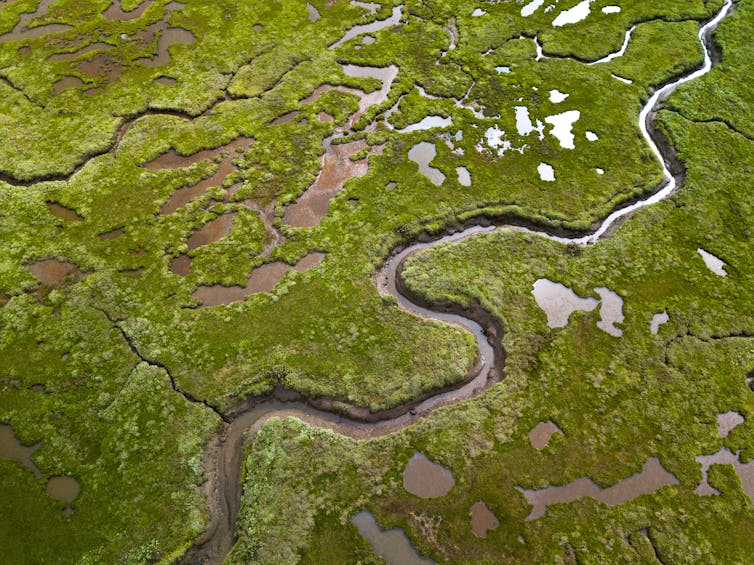
Removing several hundred billion tonnes of carbon from the atmosphere is now considered necessary to avert the worst effects of climate change. Using nature to help achieve that goal, by allowing habitats to regenerate, would seem to offer a win-win solution for the environment and the climate.
Sponsored Images




The sediments beneath mangrove forests, saltmarshes and seagrass meadows are rich in organic carbon which has built up over many hundreds of years. Businesses and states keen to offset their emissions of greenhouse gases such as carbon dioxide (CO₂) are exploring ways to do so by funding the restoration of these so-called blue carbon habitats.
Many academics and private sector groups support the idea, assuming that the rate at which these ecosystems remove CO₂ from the atmosphere can be accurately predicted well into the future.
We are researchers who study how marine life, chemistry and the climate interact, and after examining the processes by which coastal habitats draw down (and release) planet-warming gases, we’re not convinced. Whether the climate benefits from restoring these habitats – by planting mangrove trees, for example – is far from certain, and there’s a real risk that the scale at which they can mitigate emissions has been massively oversold
Our new analysis found several reasons why it is extremely difficult to work out a reliable figure for carbon accumulation by coastal ecosystems under current conditions. So we have a very shaky basis for calculating the future carbon offsets that restoration projects might provide over the next 50 to 100 years.

Causes of uncertainty
Estimates of the rate at which blue carbon habitats remove CO₂ from the atmosphere vary widely. Across several hundred scientific studies, there was a 600-fold difference between the highest and lowest estimates for carbon burial in saltmarshes, a 76-fold difference for seagrasses and a 19-fold difference for mangroves.
Applying the average value from all these studies for a particular habitat is the easiest shortcut to estimate the carbon sequestration that can be expected from a new restoration project. But the variability means that the expected carbon offsetting could be badly wrong. And because there are many low values reported with just a few very high ones, there is a much greater chance of overestimating the climate benefit.
Differences in carbon removal rates exist even over distances of just a few kilometers. Many extra measurements are needed for credible carbon accounting, but these take time and effort, raising the cost of a restoration project.
Problems run deeper than that. The carbon burial rates reported in studies are usually determined indirectly, by sampling sediment at different depths to estimate its age. Burrowing organisms disturb and mix younger and older layers, causing errors in this dating process by making sediments seem younger, and carbon burial rates greater, than they really are.

A coastal saltmarsh at Stiffkey, North Norfolk, UK.
Dronegraphica/Shutterstock
Much of the carbon buried in coastal sediments comes from elsewhere, such as soil swept from the land and carried by rivers. The proportion of imported carbon can be as little as 10% or as much as 90%. Imported carbon should be excluded from estimates used in offset accounting to clarify how much was buried as a result of restoring the habitat and how much might have simply been buried regardless.
Unfortunately, imported carbon may be more resistant to decay. In a study on one saltmarsh, the proportion of 50% imported carbon near the sediment surface increased to 80% in deeper layers. Since the deeper value represents the habitat’s long-term carbon burial rate, the direct contribution of a restored habitat to removing carbon may be much less important than thought.
Other processes which are difficult to quantify might increase rather than diminish the climate benefits of restoring blue carbon habitats. If plant debris from a coastal habitat is washed out to sea instead of accumulating in the sediment, it could still end up being stored for a long time elsewhere. It might sink to very deep water in the open ocean, for example. But scientists don’t know enough about the amounts of carbon typically involved in such processes to properly account for them.
Turning an oil palm plantation back into a mangrove forest or flooding a coastal area to make a saltmarsh should help the land accumulate carbon. But that same land could also release more methane (otherwise known as marsh gas) and nitrous oxide – both powerful greenhouse gases – leaving no net climate benefit.
That’s because these gases are formed when there is insufficient oxygen in the soil or sediment, the same conditions that favour carbon accumulation. Technically demanding measurements are needed to find out exactly what is going on.

Equipment measuring gas exchange in the sediment of an Australian mangrove swamp.
Judith Rosentreter/Southern Cross University, Author provided
And then there are calcifying animals and plants which grow in these habitats, particularly seagrass meadows. The strap-like leaves of seagrass are often covered by a white crust of shelled worms and coralline algae. When these organisms make their calcium carbonate covering, CO₂ is produced.
At an underwater meadow in Florida, more CO₂ was released than removed by the seagrass itself. At other places, conditions may favour a chemical reaction between dissolved CO₂ and carbonate in the sediment, resulting in extra carbon uptake. Again, sophisticated measurements are needed at each site to sort out the importance of these effects.

Mediterranean seagrass encrusted with coralline algae and worms with carbonate shells.
David Luquet/CNRS & Sorbonne Universit, Author provided
Finally, there’s the future to consider. Will restored coastal ecosystems withstand the ravages of climate change, including heatwaves, storms and sea level rise? And will they be sufficiently well managed to protect against encroachment by agriculture, aquaculture, tourism and other industries and activities that may have caused the habitat to disappear in the first place?
Every effort should still be made to halt, and wherever possible reverse, the worldwide loss of coastal vegetation. Blue carbon habitats are, after all, more than carbon sinks – they also protect communities from storms, nurture biodiversity and species targeted by fisheries, and improve water quality.
We fervently hope that future protection of blue carbon habitats will be effective, and that global warming can be kept below the thresholds considered critical for their survival, ranging from 2.3°C to 3.7°C above pre-industrial levels. Unfortunately, that is far from certain. And if those temperature thresholds are exceeded, newly accumulated stores of carbon may be returned to the atmosphere when the vegetation is no longer there to prevent the sediment eroding.
Since the scale of long-term carbon removal and storage by blue carbon habitats is so uncertain, it is too risky to rely on as a means of offsetting continued emissions. The consequences of failing to deliver are too great. The priority must therefore be to double down on emission reductions, only using carbon removal methods to help achieve net zero where we are confident that they will work.
Phil Williamson, Honorary Reader, University of East Anglia and Jean-Pierre Gattuso, Research Professor, CNRS, Iddri, Sorbonne Université
This article is republished from The Conversation under a Creative Commons license. Read the original article.

Dear Readers, Good and credible news reportage is tedious task and requires huge finances.
We are soliciting your Noble support for as low as N1,000 your support would go a long way in assisting us to continue to guarantee our readers quality news.
Bank transfers can be made to:
Account Name: Harvest and Commercial
Bank: Sterling Bank
Account Number: 0078627735